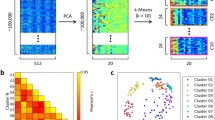Abstract.
We model the stimulus-induced development of the topography of the primary visual cortex. The analysis uses a self-organizing Kohonen model based on high-dimensional coding. It allows us to obtain an arbitrary number of feature maps by defining different operators. Using natural binocular stimuli, we concentrate on discussing the orientation, ocular dominance, and disparity maps. We obtain orientation and ocular dominance maps that agree with essential aspects of biological findings. In contrast to orientation and ocular dominance, not much is known about the cortical representation of disparity. As a result of numerical simulations, we predict substructures of orientation and ocular dominance maps that correspond to disparity maps. In regions of constant orientation, we find a wide range of horizontal disparities to be represented. This points to geometrical relations between orientation, ocular dominance, and disparity maps that might be tested in experiments.
Similar content being viewed by others
Author information
Authors and Affiliations
Additional information
Received: 9 July 1998 / Accepted in revised form: 2 June 1999
Rights and permissions
About this article
Cite this article
Wiemer, J., Burwick, T. & von Seelen, W. Self-organizing maps for visual feature representation based on natural binocular stimuli. Biol Cybern 82, 97–110 (2000). https://doi.org/10.1007/PL00007968
Issue Date:
DOI: https://doi.org/10.1007/PL00007968




